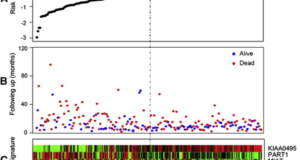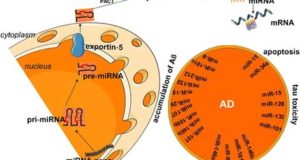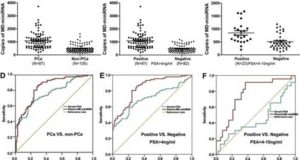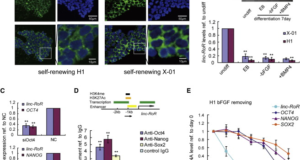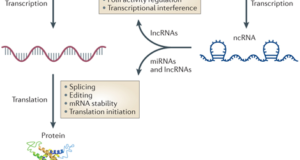A Postdoc position in the Laboratory of Genomic Screening at CIBIO, University of Trento, Italy, is available starting from Autumn 2013. Topic of the research is the interplay between lncRNA and RNA Binding Proteins in regulating the tumorigenicity of mammary cancer stem cell. Skills requested: molecular and cell biology background, previous experience on RBP or lncRNA is a plus but ...
Read More »Monthly Archives: June 2013
A long non-coding RNA signature in glioblastoma multiforme predicts survival
Long non-coding RNAs (lncRNAs) represent the leading edge of cancer research, and have been implicated in cancer biogenesis and prognosis. Researchers at The University of Hong Kong aimed to identify lncRNA signatures that have prognostic values in glioblastoma multiforme (GBM). Using a lncRNA-mining approach, they performed lncRNA expression profiling in 213 GBM tumors from The Cancer Genome Atlas (TCGA), randomly divided ...
Read More »Seminar – Chromatin State and RNA Maps Reveal Regulatory Long Noncoding RNAs in Mouse
Chromatin State and RNA Maps Reveal Regulatory Long Noncoding RNAs in Mouse Speaker: Gireesh K. Bogu, Genome Biology Group – CNAG, Barcelona, Spain Organizer: IRB Barcelona Date: Wednesday, June 19th, 09.30h Place: Aula Fèlix Serratosa, Parc Cièntific de Barcelona, Spain Host: Dr. Arturo Rodríguez
Read More »Non-coding RNAs in Alzheimer's disease
Alzheimer’s disease (AD) is a complex neurodegenerative disorder and the most common dementia among the elderly. Accumulating research indicates that noncoding RNAs (ncRNAs), especially microRNAs (miRNAs) and long noncoding RNAs (lncRNAs), are increasingly being implicated in AD. MiRNAs are conserved small ncRNAs that control gene expression post-transcriptionally while lncRNAs function in many ways. Recent profiling research in human or mouse ...
Read More »Long non-coding RNA metastasis associated in lung adenocarcinoma transcript 1 derived miniRNA as a novel plasma-based biomarker for diagnosing prostate cancer.
Examining plasma RNA is an emerging non-invasive diagnosis technique. However, whether tumour-derived long non-coding RNAs (lncRNAs) in plasma can be used as a novel approach to detect human prostate cancer (PCa) has not yet been established. The study was divided into three parts: (1) the characteristics of PCa-related lncRNA fragments were systematically studied in the plasma or serum of 25 ...
Read More »Endogenous miRNA Sponge lincRNA-RoR Regulates Oct4, Nanog, and Sox2 in Human Embryonic Stem Cell Self-Renewal
The embryonic stem cell (ESC) transcriptional and epigenetic networks are controlled by a multilayer regulatory circuitry, including core transcription factors (TFs), posttranscriptional modifier microRNAs (miRNAs), and some other regulators. However, the role of large intergenic noncoding RNAs (lincRNAs) in this regulatory circuitry and their underlying mechanism remains undefined. Here, researchers from the Second Military Medical University, China demonstrate that a ...
Read More »Featured long non-coding RNA – linc-HOXA1
Recently, researchers have uncovered the presence of many long noncoding RNAs (lncRNAs) in embryonic stem cells and believe they are important regulators of the differentiation process. However, there are only a few examples explicitly linking lncRNA activity to transcriptional regulation. Here, researchers at the University of Pennsylvania used transcript counting and spatial localization to characterize a lncRNA (dubbed linc-HOXA1) located ...
Read More »Targeting long non-coding RNA to therapeutically upregulate gene expression
The majority of currently available drugs and tool compounds exhibit an inhibitory mechanism of action and there is a relative lack of pharmaceutical agents that are capable of increasing the activity of effectors or pathways for therapeutic benefit. Indeed, the upregulation of many genes, including tumour suppressors, growth factors, transcription factors and genes that are deficient in various genetic diseases, ...
Read More »Long non-coding RNA: a new player in cancer
Emerging evidence showed that long non-coding RNAs (lncRNAs) play important roles in a wide range of biological processes and dysregulated lncRNAs are involved in many complex human diseases, including cancer. Although a few lncRNAs’ functions in cancer have been characterized, the detailed regulatory mechanisms of majority of lncRNAs in cancer initiation and progression remain largely unknown. In this review, the ...
Read More »What are lncRNAs?
from Exiqon.com It was traditionally thought that the transcriptome would be mostly comprised of mRNAs, however advances in high-throughput RNA sequencing technologies have revealed the complexity of our genome. Non-coding RNA is now known to make up the majority of transcribed RNAs and in addition to those that carry out well-known housekeeping functions (e.g. tRNA, rRNA etc), many different types ...
Read More » lncRNA Blog lncRNA Research and Industry News
lncRNA Blog lncRNA Research and Industry News

